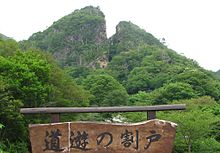
Back معدن مینه Persian Mines d'or de Sado French 佐渡金山 Japanese 사도 금광 Korean Sado aukso ir sidabro kasyklos Lithuanian Goudmijnen op het eiland Sado Dutch 佐渡金山 Chinese
You can help expand this article with text translated from the corresponding article in Japanese. (February 2022) Click [show] for important translation instructions.
|
 | |
| Location | |
|---|---|
| Niigata Prefecture | |
| Country | Japan |
| Coordinates | 38°2′29.83″N 138°15′21.17″E / 38.0416194°N 138.2558806°E |
| Production | |
| Products | Silver, gold |
| History | |
| Closed | 1989 |

The Sado gold mine (佐渡金山, Sado Kinzan) is a generic term for gold and silver mines which were once located on the island of Sado in Niigata Prefecture, Japan.[1][2] Among these mines, the Aikawa Gold and Silver Mine (相川金銀山, Aikawa kinginzan) was the largest and was in operation until the modern era. According to Korean sources copper was extracted during WWII using from 1,000 to 2,000 forced Korean laborers, drafted under Japanese colonial rule of Korea.[3][4][5] In 2015 Japan's Ambassador to UNESCO Kuni Sato acknowledged the forced labor history.[6]
The Sado Gold and Silver Mine was inscribed on Japan's World Heritage Tentative List under the title "The Sado Complex of Heritage Mines, Primarily Gold Mines" in 2010. In 2024 they were listed as UNESCO World Heritage Sites. As part of this process, Japan installed an exhibit acknowledging poor work conditions, but critics alledge there are no mentions of forced labor in the exhibit.[7][8]
- ^ "Mineral deposits of Northern Asia". docstoc.com. 2012. Retrieved 2013-07-10.
- ^ "mindat.org". mindat.org. 2011-06-22. Retrieved 2013-08-18.
- ^ "Japan and South Korea in row over mines that used forced labour". The Guardian. Retrieved 29 July 2024.
- ^ "Japan's mine associated with wartime forced labor listed as UNESCO World Heritage". The Korea Times. Retrieved 29 July 2024.
- ^ "Sado Mine Reflects 'History of Forced Labor', Should Be a Trigger for Future-Focused Korea-Japan Relations [Editorial]". Mail Business Newspaper. Retrieved 29 July 2024.
- ^ "'Japan should apologize to Korean forced labor victims'". The Korea Times. Archived from the original on 29 July 2024. Retrieved 29 July 2024.
- ^ "Foreign ministry to check for need to amend Sado mine exhibits on wartime forced labor". The Korea Herald. 2024-07-30. Retrieved 2024-07-31.
- ^ "Stripped of 'forced' labor history, Sado mines are named a World Heritage". The Hankyoreh. Retrieved 2024-07-31.
© MMXXIII Rich X Search. We shall prevail. All rights reserved. Rich X Search


